Learn to Drive
Driving lesson 10. Traffic signals and crossings
Introduction
By now you will have learnt how to deal with all the standard types of junction. Junctions that have larger volumes of traffic where major roads intersect or that are more complex are normally controlled by traffic lights. It’s also on these busier major roads that you will come across various types of pedestrian crossings. So the next logical step in your development as a driver is to learn how to deal with traffic light controlled junctions and pedestrian crossings.
![]() Lesson objectives
Lesson objectives
By the end of this lesson you should be able to:
- Explain the traffic light sequence and what each phase means
- Explain the similarities and the differences between the various types of pedestrian crossing
- Recognise traffic light controlled junctions, pedestrian crossings and school crossing patrols well in advance and apply the hazard drill on approach
- Anticipate when traffic lights are likely to change or when pedestrians might cross and be prepared to pull up or move off as necessary
- Stop in the correct position at pedestrian crossings being careful never to straddle the crossing area
- Select the correct lane at multiple lane traffic light controlled junctions well in advance and apply a signal as necessary
- Act correctly on filter lights at traffic light controlled junctions
- Observe priorities when turning right at traffic light controlled crossroads or similar junctions, being careful to position the vehicle in order to turn near-side to near -side or off-side to off-side whichever is appropriate
- Recognise when it is inappropriate to proceed even though the lights are in your favour
Subject brief
During this lesson you will learn about pedestrian crossings, light controlled junctions, traffic signals and crossing patrols.
The traffic light system
As you drive around you will encounter a range of pedestrian crossing, traffic light controlled junctions and other traffic flow control measures that use the traffic light system. All of the signals follow the same pattern of meaning.

There are several types of pedestrian crossing. In each case you must try to identify the crossing early and properly employ your hazard drill. The zig-zag lines at these crossings act as a warning that there is a pedestrian crossing ahead and mark an area where you must not park or overtake.
 You must also be careful not to cross over the studded give way line if you cannot fully clear the crossing area. Apart from the zebra these crossings are light controlled and are push button operated. Finally, when waiting at a crossing you must never beckon a pedestrian onto a crossing as you may be inviting them into danger.
You must also be careful not to cross over the studded give way line if you cannot fully clear the crossing area. Apart from the zebra these crossings are light controlled and are push button operated. Finally, when waiting at a crossing you must never beckon a pedestrian onto a crossing as you may be inviting them into danger.
Zebra
The flashing yellow light below is a Belisha Beacon. This marks the location of a zebra crossing, where you see this light you must be prepared to stop and give way to any pedestrians waiting to cross. Once a pedestrian has stepped onto the crossing you must give way and stop.
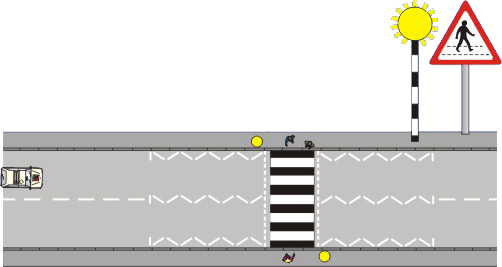
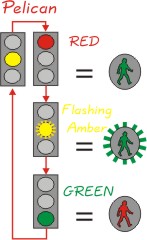 Unlike other pedestrian crossings, Pelican crossings have a flashing amber phase which requires you to give way to pedestrians on the crossing. However, if the crossing is clear you can proceed. At some pelican crossings there is a bleeping sound to indicate to blind or partially-sighted people when the steady green figure is showing. Also note that in the example below, even though there is an island in the middle it is still only one crossing. If it was two crossings it would normally be staggered with a set of lights and a button box on the island.
Unlike other pedestrian crossings, Pelican crossings have a flashing amber phase which requires you to give way to pedestrians on the crossing. However, if the crossing is clear you can proceed. At some pelican crossings there is a bleeping sound to indicate to blind or partially-sighted people when the steady green figure is showing. Also note that in the example below, even though there is an island in the middle it is still only one crossing. If it was two crossings it would normally be staggered with a set of lights and a button box on the island.

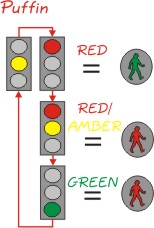 Puffin crossings have sensors that determine when the crossing is clear. The signal to change from red, to red/amber, and then to green is automatically triggered at that point. If the pedestrians at the crossing cross the road before getting the green man signal the request to stop traffic is automatically cancelled.
Puffin crossings have sensors that determine when the crossing is clear. The signal to change from red, to red/amber, and then to green is automatically triggered at that point. If the pedestrians at the crossing cross the road before getting the green man signal the request to stop traffic is automatically cancelled.
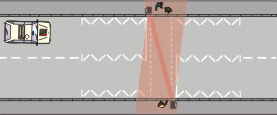
Toucan
Toucan crossings work in exactly the same way as Pelican crossings except that they are also designed to be used by cyclists and there is no flashing amber phase. Cyclists are allowed to ride across these crossings.
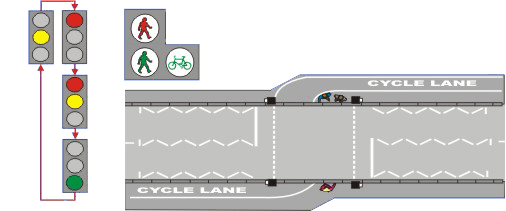
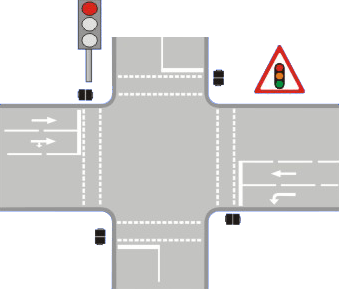 Traffic light crossings
Traffic light crossings
A pedestrian crossing can be incorporated into a normal set of traffic lights. It is still operated by a push button and the crossing area is clearly marked by two rows of studs as shown opposite. When the lights change to green you must watch carefully for pedestrians still using both crossings before you proceed.
Traffic light controlled crossroads
Even though you may have a green light indicating that you can proceed this does not change priorities with regards to oncoming vehicles.
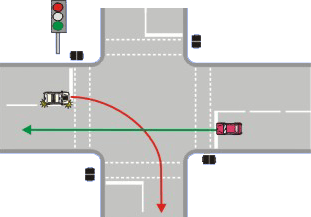
At traffic lights you may find filter lights. Even though the main traffic lights may be red if the filter light is green and pointing in the direction you wish to travel you may proceed.
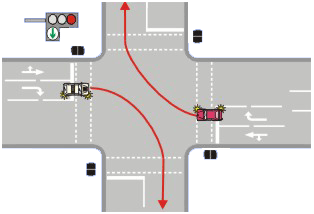
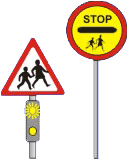 School crossing patrol
School crossing patrol
The flashing lights on the warning sign inform drivers that a school crossing patrol is ahead. You must give way to the ‘school crossing patrol officer’ on duty and be particularly careful as children will be crossing the road.
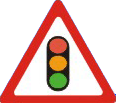 This sign is often used on the approach to traffic lights.If you see it, be prepared for possible traffic queues ahead and be ready to stop. You must always obey the signals, even if the lights are only temporary, for example, at roadworks.
This sign is often used on the approach to traffic lights.If you see it, be prepared for possible traffic queues ahead and be ready to stop. You must always obey the signals, even if the lights are only temporary, for example, at roadworks.
 These red lights flash alternately and mean that you must stop to give way to trains or emergency vehicles emerging from their depot. The steady amber light warns you that the red lights are about to show.
These red lights flash alternately and mean that you must stop to give way to trains or emergency vehicles emerging from their depot. The steady amber light warns you that the red lights are about to show.
If your car breaks down on a railway crossing you must; firstly, get your passengers to safety; secondly, if there is a railway telephone use it to warn the signal operator and thirdly, if possible, push the car off the crossing (however, if the alarm rings or the amber light comes on get well clear of the crossing).
Highway code practical references
Rules: 109, 174-178, 191-199, 210 and 291-299
Pages: 102, 104 and 105